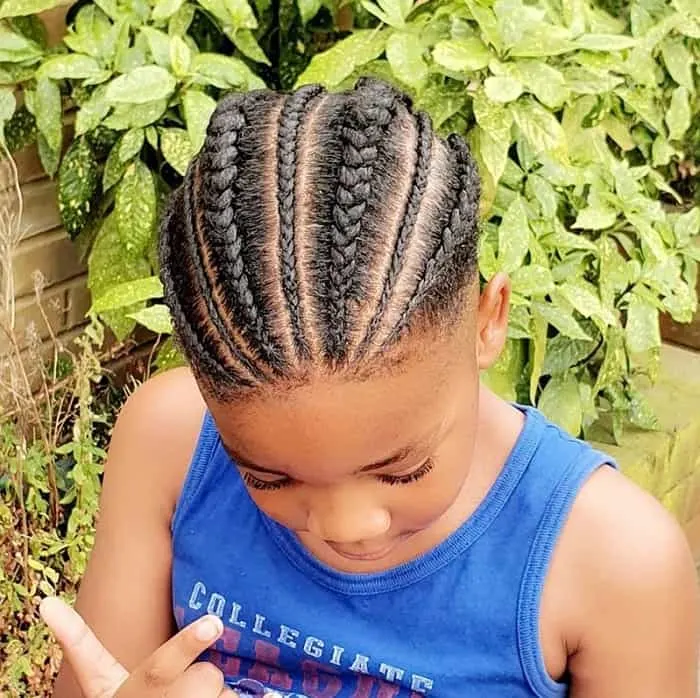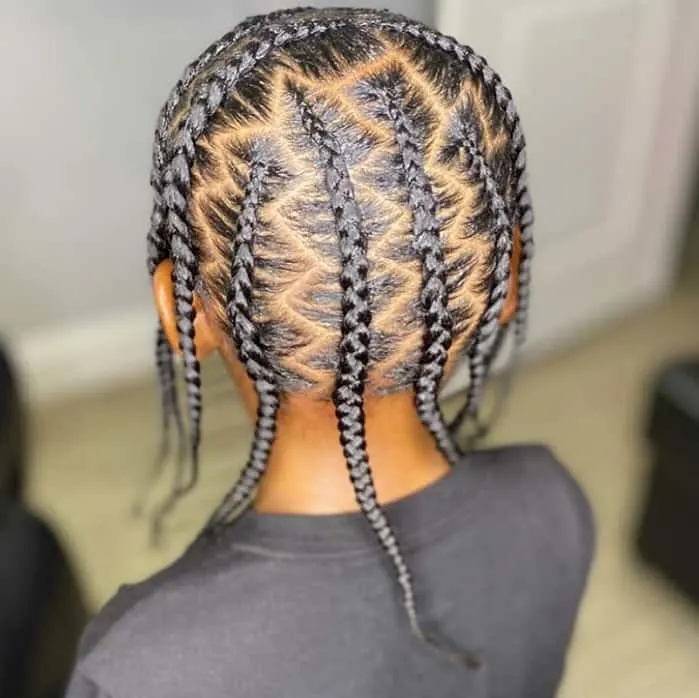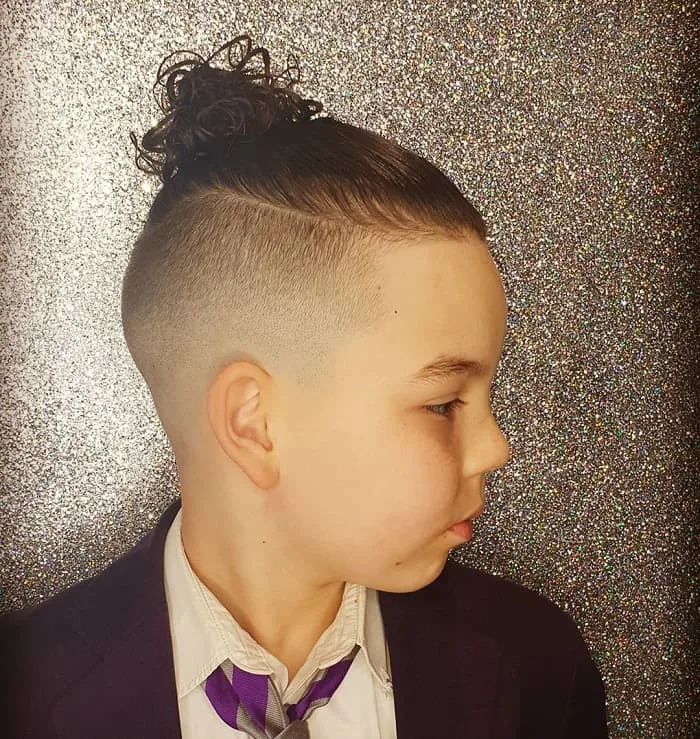Do you really remember what it feels like being a 9, 10, or 11 year old boy? Probably you have forgotten how much fun this age can be.
That explains why young boys between 9-11 years old ask their parents for a funky haircut. So before shouting that “no” to your little boy, think again about being a kid.
It is a one-time passage, and you should take advantage of this fun age. Opting for something funky for your boy’s hair is a great idea to give him a funny, crazy, and fantastic look.
Common Hairstyles for 9,10 and 11 Year Old Boys
When choosing hairstyles for young boys aged 9-11 years old, there are several popular options that are both cute and practical. The best hairstyles keep it simple yet stylish for boys this age.
Here are some common hairstyles for 9, 10, and 11 year old boys that are easy to style and maintain on school mornings!
1. Comb Over with Short Sides

When they are young, 9, 10, or 11-year-old boys have different requests when it comes to their haircuts. Some want fun looks, others want a hairstyle that looks just like their dads. And many of their role models wear a combed-over hairstyle, just like this one.
To recreate it, trim the sides shorter and keep the top long. You can also secure these longer pieces in the back, with an elastic.
2. Messy Wavy Top

If your kid has a blonde ginger hair color, matching freckles, and white skin with pink undertones, a messy high-top hairstyle will beautifully suit him.
Keep the top long, so the curls and waves can naturally form. Tease the roots to add some height and mess up your boy’s hair.
3. Buzz Cut for Black Boys

Buzz cuts are probably the most common hairstyle for 9,10 and11-year-old-boys who go to schools that impose strict hair regulations.
Moreover, the hairdo can be done by both parents at home, using a trimming machine and a no. 2 guard.
4. Green Mohawk

9,10 and11-year-old-boys love a fun haircut! Go for a trim that is short on the sides, that also gives the top length.
You can use a green colored paste to dye the top. Using some hair gel, style the hair up, on the center, creating a mohawk.
5. Medium Layered Bangs

Layer your little man’s bangs to reduce the thickness and trim the fringe one inch above the eyebrows, in a blunt line. The hairstyle will frame his face and reveal his features.
6. Side Bangs with Blonde Curls and Waves

When your little boy has curly hair, it would be best to get him a layered trim. Also, go for long bangs that go over the eyebrows and comb them on the forehead, to the side.
Those waves and ringlets will naturally fall and you won’t need to style his hair each day.
7. Shorter In Front, Long In the Back

If you want to reveal his face and still opt for a long hairstyle, then this layered haircut with bangs is the perfect choice.
Do blunt bangs that reach the eyebrow level, then gradually add length to the sides. The longest hair pieces will be in the nape area.
8. Fliped to the Side Bangs

A bowl cut with curtain bangs is probably the best idea for a little gentleman with straight blonde hair. This hairstyle works fabulously, especially when you want to show off those blue eyes that the matching natural golden locks.
If you’re getting your kid curtain bangs, remember that you don’t always have to split them in the middle. You can always toss those bangs to the side.
9. Ultra Curly Hair with Brown Tips

3C curls might feel and look unruly, so it’s mandatory to find a layered hairstyle that helps your coils beautifully set.
See a hairdresser who knows how to build that shape and bleach some ends of your coils, then paint them in a lighter brown color.
10. Curtain Bangs

A boy that’s between 9 and 11 years old will love a bowl cut with curtain bangs. The hairstyle was so popular in the 90s and it never lost its popularity, especially among kids.
It is easy to style, all you need to do is make that perfect parting in the middle.
Crazy Haircuts for 9, 10 and 11 Year Old Boys
Being either 9,10 or 11 years old boy is all about having unlimited fun. Before your boy is fully grown up to be faced with different adolescent issues, try one of these haircuts for 9,10 and 11 year old boys.
9 Year Old Boy Haircuts
11. Long Side Swept Bangs

A skater boy hairstyle is exactly what your 9-year-old kid needs if he’s a cool guy that wants to be trendy. Get him a long top and bangs that he can flip on one side and trim the laterals and back shorter.
12. Spikey Top with Glasses

Spikes and mohawks make young kids look so funky and cool. But this is certainly not a hairstyle that teachers will allow him to pull off at school. So when he wants to look his best, he’ll probably thank you for letting him get his own way with a crazy hairdo.
13. Rounded Afro

Keeping your kid’s hairstyle this long can prove to be a lot of work for a busy mom. But if you get him used to the combing and detangling from an early age, this can become a moment of the day he enjoys. On the other hand, it’s the perfect way to create a better connection with your son.
14. Messy 9 Year Old Kid’s Hair

Numerous private schools have harsh regulations on 9-year-old boy hairstyles, and this one right here might be considered too long for some institutions. On the other hand, this messy hairdo is not considered problematic for regular schools.
15. Side Swept Hair with Side Fade

You can give your little boy’s hair a perfect style, especially if he has fine hair that can be tailored to various styles and shapes you want.
This style is a typical look that can be created by styling the sides faded with short trimmed hair on the top swept to the side.
16. Slicked Back Hair with Shaved Sides

This 9-year-old boy’s haircut never leaves the fashion niche. The shaved parts match pretty well with the entire look, and the neatly combed back mane is just exciting on top.
17. Kinky Locks with Surgical Design

If your little boy has frizzy locks, trim them short to the skin and throw a bit of drama of the haircut by including a subtle cut at the front.
Exclusive short Haircuts for Teen Boys
18. Spikes with An Undercut

When spikes are incorporated with an undercut, it can turn to be a glam combo. Just include a neat and clean cut to your 9 year old kid’s hairstyle and let him rock everywhere he goes. You may need some styling product to achieve this final look.
19. Slicked Back Hair with Hard Part

This hairstyle for 9 year old boy is always in fashion. The hair is slicked at the back using a styling product, and a hard part is incorporated with an undercut for a smooth finish of the look.
20. Simple Side Swept Haircut

This is a fun and formal style that is all about side-swept hair and simplicity. The hair is messed up at the lower side of the nape. Overall, it showcases all the handsomeness of your kid.
21. Ringlet Fringe

If you’ve got a 9 year old boy with curly hair, then focus on gorgeous ringlet texture. The short hair is easy to manage and care for while the thick fringe frames eyes and gives off envy.
22. Separated Spiky Mohawk

It goes without saying that the 9 year old boy with mohawk is the coolest kid on the block. Spike hair straight up in a mohawk style and buzz hair in alternating stripes over the ear for the raddest extra detail.
23. Alternating Corn Row Braids
Cornrows are an easy no brainer style, but if you crave a style with more pop, try this alternating braided hair for 9 year old boy. Instead of even braids, alternate a thicker braid for a slimmer one in between.
24. Braided and Faded Man Bun
Undercuts provide the perfect compliment for a braided man bun for 9 year old boy. Buzzing the neck and sides of the head is practical for active boys while a cool braid on top of the head communicates style.
25. Turquoise Highlights
Why not let your child add a pop of color to their hair for personal expression? Turquoise blue looks great on ash brown hair. Focus highlights to the front and top of the head.
26. Short Twists
Braided styles are fun, but they can be a little bit basic. Twists, on the other hand, have loads of energy and are just as easy to maintain. A high and tight look is more manageable than a longer variety.
27. Short, Choppy Fringe

Short bangs were very popular in the 50s and 60s, but they are just as relevant today. Avoid blunt cuts and try a spiky, choppy look for some boyish charm.
28. Medium Hair with Layers

Layers makes a long haircut for 9 year old boy easy and fun. Try a soft side part so layered bangs can sweep to one side and feed into the longer layers cut throughout the hair.
29. Funky Buzzed Pompadour
Bold fashion statements aren’t just for grown-ups. This pompadour for 9 year old boy has the easy buzz cut many parents adore while volume at the top of the hair creates a cool style with loads of flair.
30. Caesar Bangs

A trendy short haircut for a 9 year old boy is the fashion-forward Caesar bangs. Hair should be cut very close to the scalp and bangs cut straight across the forehead in order to mirror the natural roundness of the head. It’s perfect on cute, full cheeks.
10 Year Old Boy Haircuts
31. Layered Medium Haircut

Layered medium haircuts are incredibly versatile because the hair looks good whatever you do. So that allows your son to wear those bangs on each side he wants and even go for a comb back.
32. Short Cut with Fade

This short buzz cut is probably the best idea if you need a low-maintenance hairstyle for your son. Trim his sides and back and maintain a slightly longer top. If he wants a fancier look, he can even apply hair gel.
33. Mullet

The traditional mullet inspires this medium-length hairstyle for kids, but with a modern twist. The top hair is messily tousled, and the longer back is longer and straightened. Also, it featured longer sideburns that are visible and in a pointy shape.
34. Forward Swept Spikes
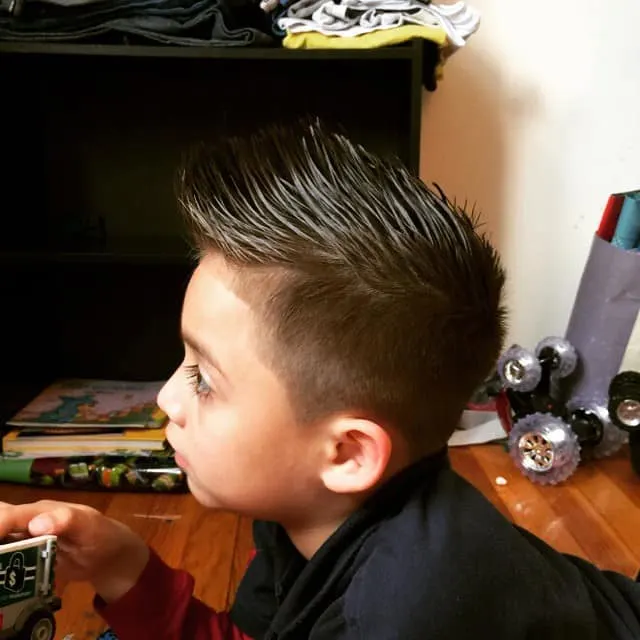
One of the cute 10 year old boy haircuts. It presents a gorgeous sporty look to your boy. However, you will need some styling product to hold your hair in place. Finger comb the hair to the front and raise them to get the final spiky look.
35. Long Side Swept Hair with High Fade

Want your kid to have a crazy yet stylish look? This is the ideal style to go for. Let him allow the hair to grow long. Sweep it to the side and finish the entire style with a cute high fade. The hard part further compliments this look.
Coolest Long Hairstyles for Boys
36. Long Forward Swept Spikes

This long forward swept haircut is all you require for your little boy to flaunt the style. It gives him a more than just a normal party look. It seems stunning and feels tenderizing. The blonde hair is let to grow long, and then side swept to the front to create this glamorous look. Besides, the sides are maintained to medium length.
37. Curly Mohawk With Surgical Design

If you are facing challenges trying to get the right 10 year old boy hairstyles for your boy’s curly hair, this curly mohawk should be definitely your hot pick. The hair is let to grow to a medium length and chopped into an elegant mohawk style. The sides are shaped and then its beauty accentuated with surgical designs.
38. Short Spikes with Surgical Design

To create this haircut, the hair is cut short, and finger combed to come up with a spiky style. The surgical design suits cricket fans who are obsessed with having cricket everywhere in their life.
39. Curly Mohawk With an Undercut

This is defined by its beautiful undercut with a different surgical design. The design resembles a flash sign that seems cool for your kid.
40. Medium Length Mohawk Haircut

Swirling all the hair to the centre is a fun and sophisticated trend that is currently being adopted by most mothers for their boys and increasing its popularity among little boys. If you are looking forward to making your 10 year old boy look handsome, this will be a good style to rock with.
41. Spiky Hair with Line Details

Chances are, your kid may ask for a 10 year old boys haircut with lines. This super trendy detail is all the rage for men and boys alike, so try it on the temple of a high and tight fade. Keep up the energy with short, spiky hair up top.
42. Choppy Bowl Cut

Bowl cuts have been ideal styles for young kids in nearly every generation. Make it relevant today by incorporating choppy layers, which are especially great at breaking up the bulk on thick hair.
43. Easy Comb over

A comb over haircut for 10 year old boys gives off that classic All American style. Cut hair close on each side of the head and smooth all of the shorter layers up top over to one side.
44. Rounded Long Buzz

If it’s done right, your child’s buzz cut will look just as great when grown out an inch or two. A round shape honors the natural shape of the scalp for an effortless look.
45. Cornrows with Zig Zag Part
Make your child’s cornrows a little more exciting by incorporating a creative zig zag part. Depending the amount of hair you’re working with, braids can be closer together or further apart.
46. Long Layers for Thin Hair

On thin hair, a long haircut for 10 year old boy should have plenty of helpful layers. A side part creates style and movement while short layers cut over the ear add the appearance of volume.
47. Curly Man Bun with Undercut
It’s sometimes easier to go for a short style like a man bun for 10 year old boy if your child has a lot of hair. Suddenly, curly styles become groomed and sleek. Smooth hair on the top of the head but maintain curls within the bun.
48. 1950s Pompadour
Today’s pompadour for 10 year old boy have a modern edge. Trim hair closest over the ears for a high and tight look that is very popular right now. Make that pompadour sky high and shape it with precision.
49. Side Part for Straight Hair

Don’t let straight hair fall flat, give it a side part haircut for 10 year old boy. It works especially well to highlight and compliment a sweet, round face and add interest to straight locks with body.
50. Line Up
There is something so cute about seeing adult haircuts on the young ones in our life. Line ups involve the straight hairline at the forehead, pictured here and are popular among trendy men haircuts. Add one to buzzcuts or braided styles.
11 Year Old Boy Haircuts
51. One Sided Top with Undercut

Inspired by David Beckham’s well-known hairstyle, this look is something you see every day in both small boys and men. The hairstyle is popular, and it features a longer top with bangs combed on one side and an undercut for both sides and back.
52. Short Layered Cut with Bangs

One of the cutest hairstyles for 11 years old boys is this short layered trim with feathered bangs that grow shorter on the corners of the forehead. The fringe is quite small, at least one finger above the eyebrows.
53. Messy Quiff

Among the most popular cuts, you can find this short trim with a quiff. The length for the sides and back varies because some prefer the hair to be as short as possible, others a little bit longer, like the one provided above. The best thing is that the longer top gives you space for manouver.
54. Mohawk With Patterns

If your boy needs some shaving, then you can have his stylist give him some pattern experiments. They can change from simple lines or geometrical figures to phrases or even letters as seen in this boy’s cut.
Have A Look at These 5 Year Old Boy Haircuts
55. Dye It

Outrageous hues might give you a shock as a parent, but your kid will surely like it. Allow your 11 year old boy to be a real Rockstar with this stunning color. You can begin with blue and proceed to red and green. It is a sure way to make your little boy shine in style and pleasure.
56. Make an Explosion

This 11 year old boy haircut doesn’t look too outrageous. If your kid has an elongated hair, let him rock with this real messy haircut. Utilize some styling gel to hold it up.
57. Wild Curls

If your boy has wavy hair, create some unruly curls by using some styling gel on the wet hair and give it some time to dry. It is a simple hairstyle for 11 year old boy that will provide a sense of satisfaction to both you and your little lad.
58. Rainbow
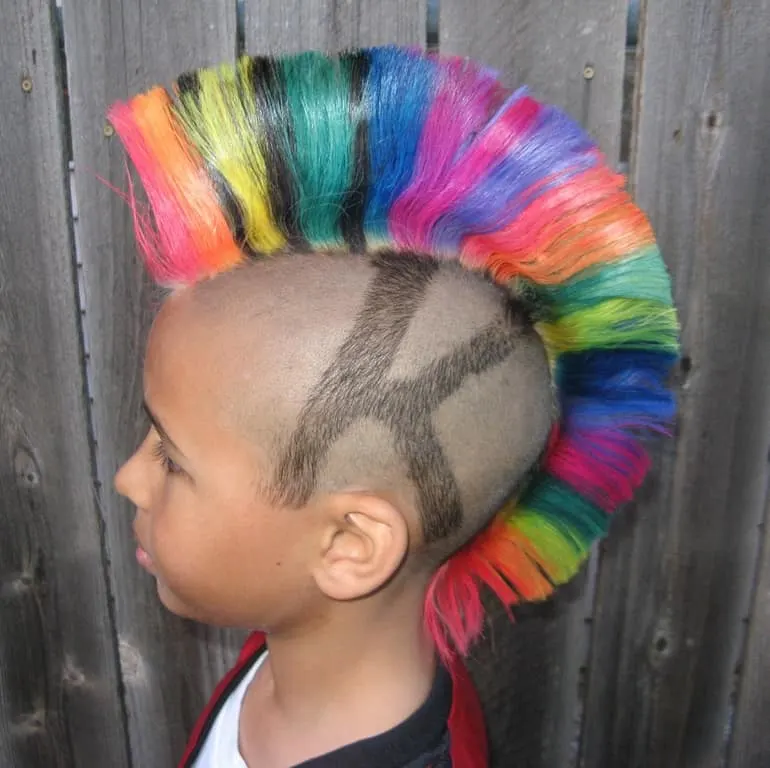
Experimentation with colors is possible and fun especially when you are a little boy. So, don’t deny your 11 year old boy this precious opportunity to have fun with shades. Use some temporary hair dye and let her personality run wild. The outcome can be astonishing, and you will like it.
59. Short Side Swept Hair with Surgical Design

This is a gorgeous haircut that actually defines itself by the short manes on the sides. They are perfectly styled into an excitingly exhaustive surgical design. The top hair is beautifully styled into a side swept look adding a neat texture with styling product.
Easy Preschool Haircuts for Little Boys
60. The Army Man Hairstyle

This truly resembles an army man. The top hair is maintained to mid-length, and a medium fade is created on the sides that make this haircut one of the best for 11 year old boys, representing a commando look. This haircut looks great on straight and silky hair.
61. Side Part Comb over

For a sleek and masculine haircut, look no further than this 11 year old boy with side part haircut. A temple fade makes it feel relevant for 202o while a fresh part and gentle comb over has classic style that men have rocked for decades.
62. Spiky Textured Fade
Contrast a soft fade haircut for 11 year old boy with spiky, bleach blonde texture up top. Because this fade stops at the top corner of the forehead, it’s a high fade, but a medium or low fade can work, depending on hair texture.
63. Short and Thick Afro

Embrace beautiful texture with this haircut for 11 year old black boy. Afros are the expressive style your son needs to show off natural curls. The round shape is perfect for drawing the eye in towards a sweet face.
64. Long Wiry Curls
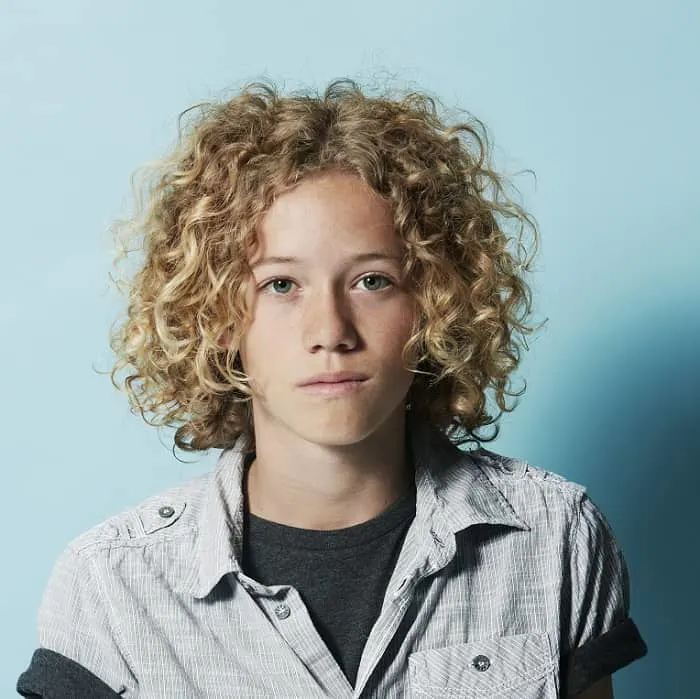
There is no point in hiding lively curls, so display them with a long haircut for 11 year old boy. Ask the stylist to cut shorter layers under the cheekbones to elongate the appearance of the chin and enhance the face’s natural shape.
65. Short and Choppy Style

A short and choppy cut is perfect on mousy brown hair that doesn’t contain much natural texture or volume. Get your hands on a lightweight wax or pomade and spike straight hair up and slightly to one side.
66. Center Part Braids
Braids with center parts is a popular style for guys today, so it makes perfect sense as a style for 11 year old boys. Longer braids work best when they hit just at the cheekbones to make a jawline appear more pronounced.
67. Sandy Dreadlocks

Dreadlocks represent such a special expression of personal style, so if your child is interested in them, it may be worth it to go for it. They do require a lot of care, so be sure that your child is up to the task of rocking this distinctive style.
68. Extra Long Fringe

A long and swooping fringe style is ideal for medium hair and a soft, round face. While it works for every hair color, it looks especially cute on dirty, sandy blonde locks.
69. Shag with Thick Fringe

Shags are such a cool, timeless style for anyone who wears them. They may be perfect for the young boy in your life if he has lots of hair with good texture. A long, thick fringe completes the look.
70. Half-Up Short Style

Working with a short style with plenty of hair up top? A half-up style is an easy, yet cool way to pull hair back for homework, sports, or any type of activity.
So, those are some of the best and trendiest 9,10 and 11 year old boy haircuts ideas that you can consider for your kid. You need to ensure that you select the right haircut that will look great on your kid and importantly that which will be in line with his personality.
Little boys love to be listened to, so his opinion on the type of style he wants shouldn’t be taken for granted. Regardless of choice you go for, you and your lad will surely love it.

